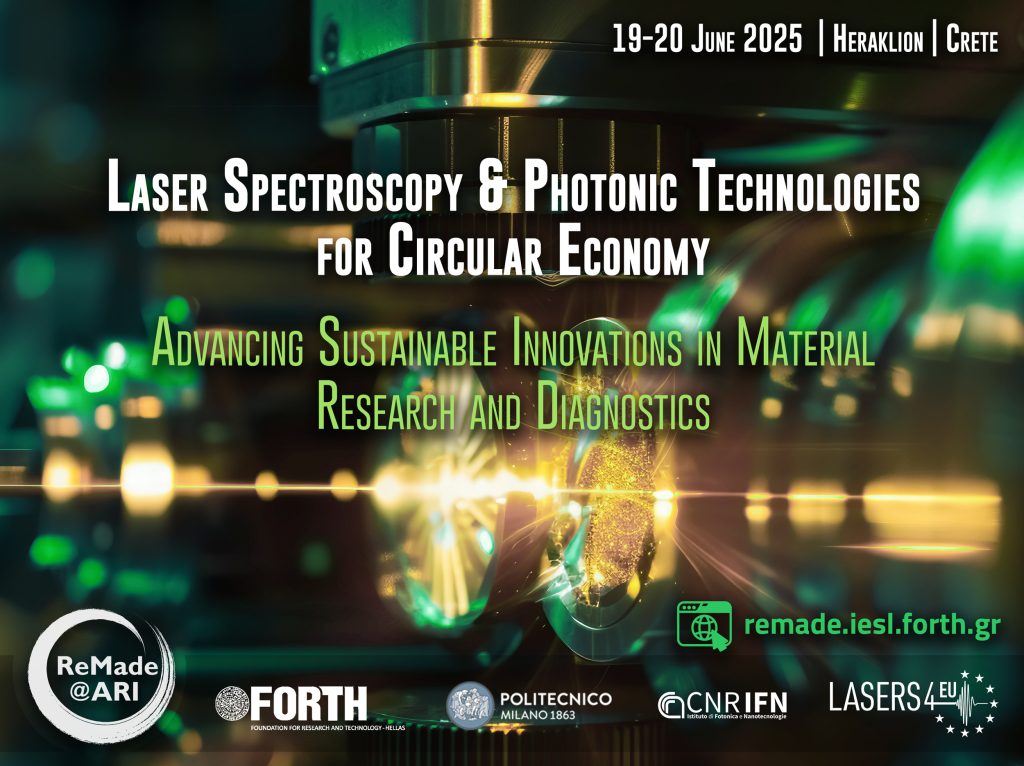The workshop will take place over two full days, starting on Thursday, June 19th, at 8:30 AM, and concluding on Friday, June 20th, at 5:00 PM (local time).
A detailed agenda will be shared soon.
PROGRAM OUTLINE
Thursday 19 June 2025
| 08:30-09:00 | Registration |
| 09:00-09:40 | Welcome |
| 09:40-10:20 | Laser Spectroscopy session |
| 10:20-10:50 | Coffee break |
| 10:50-11:50 | Laser Spectroscopy session (cont.) |
| 12:00-13:00 | IESL Lab tour |
| 13:00-14:30 | Lunch |
| 14:30-15:50 | Photonics session: Imaging and Sensing |
| 15:50-16:10 | Coffee break |
| 16:10-17:10 | Photonics session: Imaging and Sensing (cont.) |
| 17:15 | Networking and Refreshments |
Friday 20 June 2025
| 09:00-10:40 | Industry session |
| 10:40-11:00 | Coffee break |
| 11:00-13:00 | Demonstration/ Hands On session I* Hyper-spectral imaging |
| 13:00-14:30 | Lunch |
| 14:30-16:30 | Demonstration/ Hands On session II* Laser spectroscopy techniques |
| 16:30-17:00 | Closing remarks/feedback |
* Depending on number of participants hands on sessions can also run in parallel.
A detailed agenda will be shared soon.
HANDS-ON SESSIONS
- Hyperspectral Imaging
Unlike traditional RGB imaging, which captures only three spectral bands, hyperspectral imaging (HSI) collects the entire spectrum from every point in the field of view, producing the “spectral cube”: a stack of images taken at a large number of wavelengths. HSI synergistically combines the spatial correlations typical of imaging with the chemometric information provided by spectra, thus enabling the identification of materials in an inhomogeneous sample. This technology has been widely used since the 1970s in several fields such as remote sensing, medical imaging, astronomy, agriculture, and conservation science, and can now become a key technology for sorting materials in the circular economy.
- Laser Spectroscopy
This hands-on experimental demonstration will provide participants with a practical understanding of how to use laser spectroscopy techniques for the analysis and characterization of surfaces and materials. The following techniques will be demonstrated:
- LIBS: Laser Induced Breakdown Spectroscopy enables the determination of the elemental composition of materials on the basis of the characteristic atomic emission from a micro-plasma produced by focusing a high-power laser on, a solid surface. It is widely used in various analytical applications for qualitative, semi-quantitative, and quantitative material analysis. LIBS is a rapid, micro-destructive technique that can be performed both at close range and remotely (from distances of up to hundreds of meters). It can be used for bulk analysis, depth profiling (elemental distribution with depth), and 2D and 3D chemical mapping.
- Raman: Raman spectroscopy is a well-established analytical technique that probes vibrational and other low-frequency modes in molecules and materials. As a result, it provides an accurate look into chemical bonding, thereby enabling identification of various types of materials, both inorganic and organic. Raman spectroscopy features high sensitivity and specificity, it is rapid, non-destructive, and can be performed in situ. When performed using a Raman microscope, it offers superb spatial resolution and minimal analysis time.
Following a brief introduction to the fundamental principles and instrumentation of both techniques, participants will have the opportunity to use a Raman microscope and a micro-LIBS instrument (developed at IESL-FORTH) to analyse various materials. Participants are encouraged to contact us in advance if they wish to bring their own samples for potential analysis during the demonstration.



